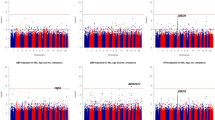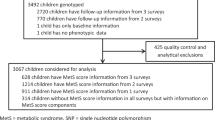Abstract
Context:
Recent genome-wide association studies have identified several single-nucleotide polymorphisms (SNPs) that are associated with body mass index (BMI)/obesity.
Objective:
As obesity is an independent risk factor for hypertension, the objective of the study was to investigate the associations of obesity susceptibility loci with blood pressure (BP)/hypertension in a population of Chinese children.
Design, setting and participants:
This was a genotype–phenotype association study. Participants included 3077 Chinese children, aged 6–18 years. Based on the Chinese age- and sex-specific BP standards, 619 hypertensive cases and 2458 controls with normal BP were identified.
Main outcome measures:
BP was measured by auscultation using a standard clinical sphygmomanometer.
Results:
Of the 11 SNPs, only FTO rs9939609 was significantly associated with systolic BP (SBP; P=0.034) and three SNPs were significantly associated with diastolic BP (DBP; GNPDA2 rs10938397: P=0.026; FAIM2 rs7138803: P=0.015; NPC1 rs1805081: P=0.031) after adjustment for age, sex and hypertension status. In addition, three SNPs were significantly associated with hypertension risk after adjustment for age and sex (FTO rs9939609: odds ratio (OR)=1.35, 95% confidence interval (CI) 1.12–1.62, P=0.001; MC4R rs17782313: OR=1.22, 95% CI 1.06–1.42, P=0.007; GNPDA2 rs10938397: OR=1.17, 95% CI 1.02–1.34, P=0.021). After additional adjustment for BMI, none remained significant. The genetic risk score (GRS), based on three significant SNPs (FTO rs9939609, MC4R rs17782313, GNPDA2 rs10938397), showed a positive association with SBP (P=5.17 × 10−4) and risk of hypertension (OR=1.22, 95% CI 1.12–1.33, P=6.07 × 10−6). Further adjustment for BMI abolished the positive associations (SBP: P=0.220; DBP: P=0.305; hypertension: P=0.052). Only FTO rs9939609 and GRS were statistically associated with hypertension risk in the age- and sex-adjusted model after correction for multiple testing.
Conclusions:
The present study demonstrated that FTO rs9939609 and combined SNPs were significantly associated with risk of hypertension, which seems to be dependent on BMI.
This is a preview of subscription content, access via your institution
Access options
Subscribe to this journal
Receive 12 print issues and online access
$259.00 per year
only $21.58 per issue
Buy this article
- Purchase on Springer Link
- Instant access to full article PDF
Prices may be subject to local taxes which are calculated during checkout
Similar content being viewed by others
References
Lewington S, Clarke R, Qizilbash N, Peto R, Collins R, Prospective Studies Collaboration. Age-specific relevance of usual blood pressure to vascular mortality: a meta-analysis of individual data for one million adults in 61 prospective studies. Lancet 2002; 360: 1903–1913.
Xi B, Cheng H, Shen Y, Zhao XY, Hou DQ, Wang XY et al. Physical activity modifies the associations between genetic variants and hypertension in the Chinese children. Atherosclerosis 2012; 225: 376–380.
Nguyen T, Lau DC . The obesity epidemic and its impact on hypertension. Can J Cardiol 2012; 28: 326–333.
Xi B, Liang Y, Mi J . Hypertension trends in Chinese children in the national surveys, 1993 to 2009. Int J Cardiol 2012. e-pub ahead of print 29 September 2012; doi: 10.1016/j.ijcard.2012.09.032.
Xi B, Liang Y, Reilly KH, Wang Q, Hu Y, Tang W . Trends in prevalence, awareness, treatment, and control of hypertension among Chinese adults 1991-2009. Int J Cardiol 2012; 158: 326–329.
Frayling TM, Timpson NJ, Weedon MN, Zeggini E, Freathy RM, Lindgren CM et al. A common variant in the FTO gene is associated with body mass index and predisposes to childhood and adult obesity. Science 2007; 316: 889–894.
Loos RJ, Lindgren CM, Li S, Wheeler E, Zhao JH, Prokopenko I et al. Common variants near MC4R are associated with fat mass, weight and risk of obesity. Nat Genet 2008; 40: 768–775.
Thorleifsson G, Walters GB, Gudbjartsson DF, Steinthorsdottir V, Sulem P, Helgadottir A et al. Genome-wide association yields new sequence variants at seven loci that associate with measures of obesity. Nat Genet 2009; 41: 18–24.
Willer CJ, Speliotes EK, Loos RJ, Li S, Lindgren CM, Heid IM et al. Six new loci associated with body mass index highlight a neuronal influence on body weight regulation. Nat Genet 2009; 41: 25–34.
Benzinou M, Creemers JW, Choquet H, Lobbens S, Dina C, Durand E et al. Common nonsynonymous variants in PCSK1 confer risk of obesity. Nat Genet 2008; 40: 943–945.
Meyre D, Delplanque J, Chèvre JC, Lecoeur C, Lobbens S, Gallina S et al. Genome-wide association study for early-onset and morbid adult obesity identifies three new risk loci in European populations. Nat Genet 2009; 41: 157–159.
Speliotes EK, Willer CJ, Berndt SI, Monda KL, Thorleifsson G, Jackson AU et al. Association analyses of 249,796 individuals reveal 18 new loci associated with body mass index. Nat Genet 2010; 42: 937–948.
Wen W, Cho YS, Zheng W, Dorajoo R, Kato N, Qi L et al. Meta-analysis identifies common variants associated with body mass index in east Asians. Nat Genet 2012; 44: 307–311.
Okada Y, Kubo M, Ohmiya H, Takahashi A, Kumasaka N, Hosono N et al. Common variants at CDKAL1 and KLF9 are associated with body mass index in east Asian populations. Nat Genet 2012; 44: 302–306.
Xi B, Shen Y, Zhang M, Liu X, Zhao X, Wu L et al. The common rs9939609 variant of the fat mass and obesity-associated gene is associated with obesity risk in children and adolescents of Beijing, China. BMC Med Genet 2010; 11: 107.
Wu L, Xi B, Zhang M, Shen Y, Zhao X, Cheng H et al. Associations of six single nucleotide polymorphisms in obesity-related genes with BMI and risk of obesity in Chinese children. Diabetes 2010; 59: 3085–3089.
Xi B, Shen Y, Reilly KH, Zhao X, Cheng H, Hou D et al. Sex-dependent associations of genetic variants identified by GWAS with indices of adiposity and obesity risk in a Chinese children population. Clin Endocrinol (Oxf) 2012. e-pub ahead of print 3 November 2012; doi:10.1111/cen.12091.
Shan XY, Xi B, Cheng H, Hou DQ, Wang Y, Mi J . Prevalence and behavioral risk factors of overweight and obesity among children aged 2-18 in Beijing, China. Int J Pediatr Obes 2010; 5: 383–389.
Mi J, Wang TY, Meng LH, Zhu GJ, Han SM, Zhong Y et al. Development of blood pressure reference standards for Chinese children and adolescents. Chin J Evid Based Pediatr 2010; 5: 4–14.
National High Blood Pressure Education Program Working Group on High Blood Pressure in Children and Adolescents. The fourth report on the diagnosis, evaluation, and treatment of high blood pressure in children and adolescents. Pediatrics 2004; 114: 555–576.
Chen X, Wang Y, Appel LJ, Mi J . Impacts of measurement protocols on blood pressure tracking from childhood into adulthood: a meta-regression analysis. Hypertension 2008; 51: 642–649.
Levy D, Ehret GB, Rice K, Verwoert GC, Launer LJ, Dehghan A et al. Genome-wide association study of blood pressure and hypertension. Nat Genet 2009; 41: 677–687.
Li H, Kilpeläinen TO, Liu C, Zhu J, Liu Y, Hu C et al. Association of genetic variation in FTO with risk of obesity and type 2 diabetes with data from 96,551 East and South Asians. Diabetologia 2012; 55: 981–995.
Xi B, Takeuchi F, Chandak GR, Kato N, Pan HW . AGEN-T2D Consortium Zhou DH et al. Common polymorphism near the MC4R gene is associated with type 2 diabetes: data from a meta-analysis of 123,373 individuals. Diabetologia 2012; 55: 2660–2666.
Freathy RM, Timpson NJ, Lawlor DA, Pouta A, Ben-Shlomo Y, Ruokonen A et al. Common variation in the FTO gene alters diabetes-related metabolic traits to the extent expected given its effect on BMI. Diabetes 2008; 57: 1419–1426.
Sjögren M, Lyssenko V, Jonsson A, Berglund G, Nilsson P, Groop L et al. The search for putative unifying genetic factors for components of the metabolic syndrome. Diabetologia 2008; 51: 2242–2251.
Timpson NJ, Harbord R, Davey Smith G, Zacho J, Tybjaerg-Hansen A, Nordestgaard BG . Does greater adiposity increase blood pressure and hypertension risk?: Mendelian randomization using the FTO/MC4R genotype. Hypertension 2009; 54: 84–90.
Pausova Z, Syme C, Abrahamowicz M, Xiao Y, Leonard GT, Perron M et al. A common variant of the FTO gene is associated with not only increased adiposity but also elevated blood pressure in French Canadians. Circ Cardiovasc Genet 2009; 2: 260–269.
Ahmad T, Chasman DI, Mora S, Paré G, Cook NR, Buring JE et al. The fat-mass and obesity-associated (FTO) gene, physical activity, and risk of incident cardiovascular events in white women. Am Heart J 2010; 160: 1163–1169.
Hotta K, Kitamoto T, Kitamoto A, Mizusawa S, Matsuo T, Nakata Y et al. Association of variations in the FTO, SCG3 and MTMR9 genes with metabolic syndrome in a Japanese population. J Hum Genet 2011; 56: 647–651.
Melka MG, Bernard M, Mahboubi A, Abrahamowicz M, Paterson AD, Syme C et al. Genome-wide scan for loci of adolescent obesity and their relationship with blood pressure. J Clin Endocrinol Metab 2012; 97: E145–E150.
Razquin C, Marti A, Martinez JA . Evidences on three relevant obesogenes: MC4R, FTO and PPARγ. Approaches for personalized nutrition. Mol Nutr Food Res 2011; 55: 136–149.
Guyenet PG . The sympathetic control of blood pressure. Nat Rev Neurosci 2006; 7: 335–346.
Acknowledgements
This work was supported by National Basic Research Program of China (973 Program, 2013CB530605), Beijing Health System Leading Talent Grant (2009-1-08), Beijing Key Science and Technology Program (D111100000611002), the Research Fund for the Doctoral Program of Higher Education of China (20120131120004) and the Foundation for Outstanding Young Scientist in Shandong Province (BS2011YY026).
Author Contributions
Study concept and design: JM. Acquisition of data: XZ, YS, LW, KH, DH and HC. Analysis and interpretation of data: BX and XZ. Drafting of the manuscript: BX and XZ. Critical revision of the manuscript for important intellectual content: BX, XZ, YS, LW, KH, DH, HC, XW and JM. Funding recepients: JM and BX.
Author information
Authors and Affiliations
Corresponding author
Ethics declarations
Competing interests
The authors declare no conflict of interest.
Additional information
Supplementary Information accompanies this paper on International Journal of Obesity website
Supplementary information
Rights and permissions
About this article
Cite this article
Xi, B., Zhao, X., Shen, Y. et al. Associations of obesity susceptibility loci with hypertension in Chinese children. Int J Obes 37, 926–930 (2013). https://doi.org/10.1038/ijo.2013.37
Received:
Revised:
Accepted:
Published:
Issue Date:
DOI: https://doi.org/10.1038/ijo.2013.37
Keywords
This article is cited by
-
Familial Aggregation and Childhood Blood Pressure
Current Hypertension Reports (2015)
-
The bigger picture of FTO—the first GWAS-identified obesity gene
Nature Reviews Endocrinology (2014)
-
An obesity genetic risk score predicts risk of insulin resistance among Chinese children
Endocrine (2014)
-
Novel association of the obesity risk-allele near Fas Apoptotic Inhibitory Molecule 2 (FAIM2) gene with heart rate and study of its effects on myocardial infarction in diabetic participants of the PREDIMED trial
Cardiovascular Diabetology (2014)



